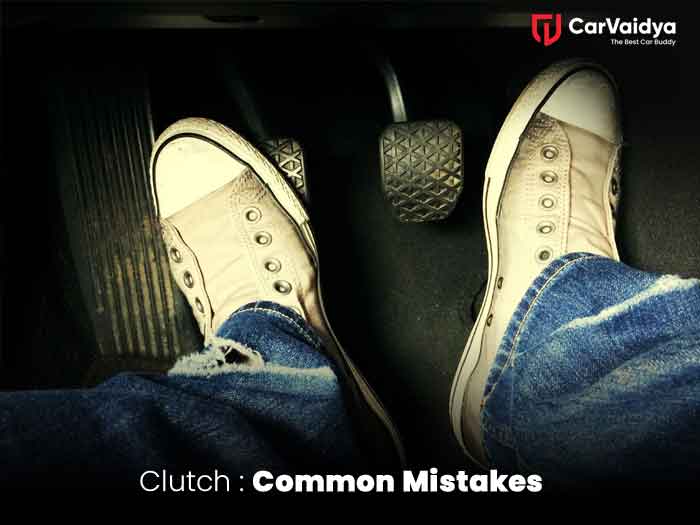Driving is a skill that requires constant attention and care to ensure the longevity and efficiency of your vehicle similar to quality car servicing. Among the various components that play a crucial role in a car's performance, the clutch holds a significant position. However, many drivers unknowingly make mistakes that can lead to premature wear and tear of the clutch and a decrease in fuel efficiency. In this article, we will discuss four common driving mistakes that can potentially damage your car's clutch and result in reduced mileage.
Riding the Clutch
One of the most common mistakes that drivers make is "riding the clutch". This refers to keeping your foot on the clutch pedal when it's not actively being used for shifting gears. Some drivers have a habit of partially engaging the clutch even when not changing gears, thinking it provides better control. However, this practice puts unnecessary strain on the clutch mechanism, leading to increased wear and damage to the clutch system. Users can find the best Clutch repair workshop at CarVaidya for any servicing and maintenance required.
When the clutch pedal is pressed down, it disengages the engine from the transmission, allowing the driver to shift gears smoothly. Keeping the clutch pedal partially depressed causes the clutch to slip, generating heat and causing premature wear of the friction material. Over time, this can lead to a worn-out clutch, resulting in poor performance and decreased fuel efficiency.
To avoid riding the clutch, make sure to fully release the pedal after shifting gears. Only engage the clutch when necessary for changing gears, and avoid resting your foot on the pedal when driving.
Resting Your Foot on the Brake and Clutch Simultaneously
Another common mistake that can harm your car's clutch is resting your foot on both the brake and the clutch pedals simultaneously. This often happens when drivers use both feet for driving, keeping one on the brake and the other on the clutch. The problem arises when the clutch is partially engaged while applying the brake, causing unnecessary wear.
Simultaneously depressing the brake and clutch pedals results in the same issue as riding the clutch. The clutch remains engaged, leading to heat generation and increased wear on the friction surfaces. This can significantly reduce the lifespan of the clutch and force you to find the "best clutch repair workshop near me" on Google for repairing purposes and adversely affect fuel efficiency.
To avoid this mistake, use only one foot for both the brake and the accelerator pedals. Ensure that you fully release the clutch pedal when it's not actively engaged in shifting gears. This practice not only protects the clutch but also promotes safer driving habits.
Delayed Gear Shifting
Another driving habit that can harm your car's clutch is delayed gear shifting. Some drivers tend to hold the clutch pedal down for an extended period while deciding on the next gear. This prolonged engagement puts unnecessary stress on the clutch mechanism, leading to faster wear and tear.
When the clutch is kept depressed for too long, the friction material heats up, and the clutch components wear out more quickly. This not only affects the clutch but also results in decreased fuel efficiency, as the engine remains disconnected from the transmission for an extended duration.
To prevent delayed gear shifting, practice smooth and timely gear changes. Anticipate the need to shift gears and engage the clutch only when necessary. This not only extends the life of your clutch but also contributes to a more efficient driving experience.
Aggressive Driving and High RPM Shifting
Aggressive driving, especially with high RPM (revolutions per minute) shifting, is a common mistake that can significantly impact your car's clutch and fuel efficiency. Rapid acceleration, abrupt deceleration, and shifting at excessively high RPMs put immense stress on the clutch and other drivetrain components.
When you rev the engine too high before shifting gears, it causes a sudden and forceful engagement of the clutch. This places additional strain on the clutch disc and other components, leading to accelerated wear. Additionally, aggressive driving can result in frequent and abrupt gear changes, further contributing to clutch wear and reduced fuel efficiency.
To mitigate the impact of aggressive driving, practice smooth acceleration and deceleration. Shift gears at reasonable RPM levels, avoiding unnecessary strain on the clutch. Consistent and moderate driving habits not only preserve the clutch but also promote better fuel economy.
Maintaining a healthy clutch and ensuring optimal fuel efficiency requires conscious effort from the driver. By avoiding common mistakes such as riding the clutch, resting your foot on both pedals, delayed gear shifting, and aggressive driving, you can extend the life of your car's clutch and improve overall performance. Adopting smooth and thoughtful driving habits not only benefits your vehicle but also contributes to a safer and more fuel-efficient driving experience. Remember, the key to a long-lasting clutch and better mileage lies in careful and attentive driving.
You can read some other articles
Tips for Choosing The Right Car Loan What To Consider
Early Discoloration of Car Engine Oil
Know Everything about Car Service History Report


0 Comments